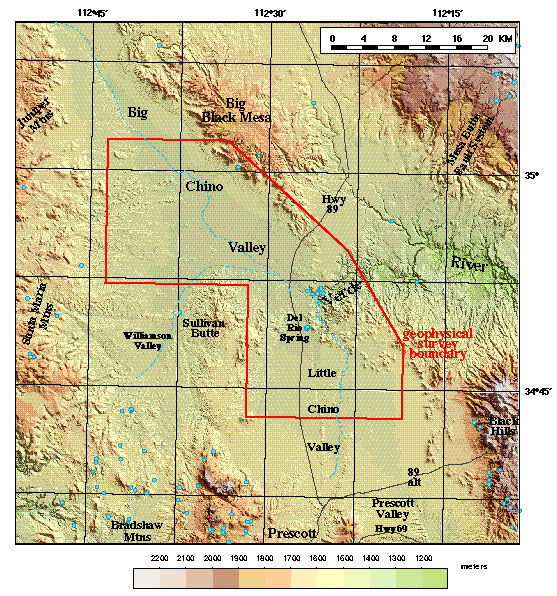 Abstract Abstract
This report summarizes the acquisition, data processing, and preliminary interpretation of a high-resolution aeromagnetic and radiometric survey near the confluence of the Big and Little Chino basins in the headwaters of the Verde River, Arizona. The goal of the aeromagnetic study is to improve understanding of the geologic framework as it affects groundwater flow, particularly in relation to the occurrence of springs in the upper Verde River headwaters region. Radiometric data were also collected to map surficial rocks and soils, thus aiding geologic mapping of the basin fill. Additional gravity data were collected to enhance existing coverage.
Both aeromagnetic and gravity data indicate a large gradient along the Big Chino fault, a fault with Quaternary movement. Filtered aeromagnetic data show other possible faults within the basin fill and areas where volcanic rocks are shallowly buried. Gravity lows associated with Big Chino and Williamson Valleys indicate potentially significant accumulations of low-density basin fill. The absence of a gravity low associated with Little Chino Valley indicates that high-density rocks are shallow.
The radiometric maps show higher radioactivity associated with the Tertiary latites and with the sediments derived from them. The surficial materials on the eastern side of the Big Chino Valley are significantly lower in radioactivity and reflect the materials derived from the limestone and basalt east of the valley. The dividing line between the low radioactivity materials to the east and the higher radioactiviy materials to the west coincides approximately with the major drainage system of the valley, locally known as Big Chino Wash. This feature is remarkably straight and is approximately parallel to the Big Chino Fault. The uranium map shows large areas with concentrations greater than 5 ppm eU, and we expect that these areas will have a significantly higher risk potential for indoor radon.
|
First posted November 29, 2000
For more information about gravity and magnetic data and methods, check out the Geophysical Unit of Menlo Park website
Part or all of this report is presented in Portable Document Format (PDF). For best results viewing and printing PDF documents, it is recommended that you download the documents to your computer and open them with Adobe Reader. PDF documents opened from your browser may not display or print as intended. Download the latest version of Adobe Reader, free of charge.
|